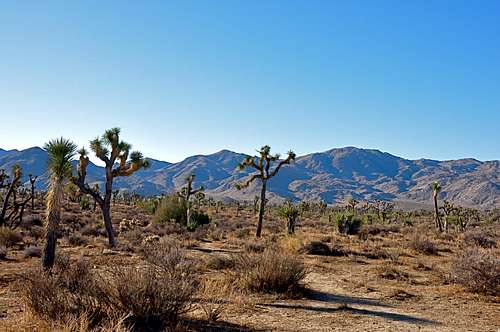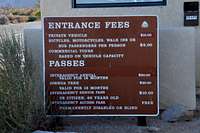-
 3635 Hits
3635 Hits
-
 87.76% Score
87.76% Score
-
 25 Votes
25 Votes
|
|
Mountain/Rock |
|---|---|
|
|
34.01244°N / 116.1681°W |
|
|
Riverside |
|
|
Trad Climbing |
|
|
Spring, Summer, Fall, Winter |
|
|
4100 ft / 1250 m |
|
|
Overview
Locomotion Rock is a formation in the Real Hidden Valley area of Joshua Tree National Park, California.
There are over a dozen formations in the Real Hidden Valley area of Joshua Tree National Park. Some of these formations offer steep difficult climbing such as Sport Challenge Rock. Some others offer great top roping possibilities such as Thin Wall. Locomotion Rock is somewhat different from the rest in that it is the shortest formation in the area. In contrast to Thin Wall, it offers low angle crack climbing. It's a great formation to practice beginner level lead climbing. You can practice gear placement and learn the basics of crack climbing on low angle rock.
During the peak climbing season, you may often see groups of friends top roping the many possible routes on this small formation. Unless you are looking for some solitude, this rock may be a good alternative for an easy day of working out. This formation is also a good location for holding climbing classes.
Note: Locomotion Rock is a popular destination for many climbers. It is a good idea to share routes with other visiting climbers, even if they have arrived after you. You may find a worthy future climbing partner amongst the visiting late arrivals.
Select Routes
At first glance, Locomotion Rock looks small and insignificant. You would, however, be surprised to know that there are at least a dozen different routes on this formation. The most popular routes are in the center of the rock leading to two-bolt anchors. The most sought-after route is Leaping Leaner, rated 5.6. If you like to get a taste of 5.11 slab climbing, you can top rope the face to the right of Leaping Leaner using the same anchor point.
Another popular route following a crack on the left side of the Locomotion Rock is Jumping Jehoshaphat, rated 5.7. This route also sports a two-bolt anchor on its top. You may even be interested in some of the shorter routes along the cracks on the right side of the formation. Jump Back Loretta, 5.5 follows a right facing corner crack that is perfect for a beginner lead.
List of the select routes
Select Routes of Locomotion Rock | |
| A | Jumping Jehoshaphat, 5.7, standard rack, anchor |
| B | Leaping Leaner, 5.6, Standard Rack, pro to 3", anchor |
| C | Lumping Fat Jennie, 5.7, Standard Rack, pro to 3" |
| D | Jump Back Loretta, 5.5, standard rack, pro to 3". Note: This route is on the extreme right side of the formation. |
How to Get There
From the western entrance to Joshua Tree National Park drive on Park Boulevard, formerly known as Quail Springs Road, for about nine miles to a major rock formation called “Intersection Rock.” Intersection Rock is a major landmark on the north side of Park Boulevard with ample parking for visitors and climbers alike. This rock, true to its name, sit at the cross roads to Hidden Valley Campground, Barker Dam Road and the road to Day use and picnic area.
Turn right onto the road leading to day use area with a large parking lot and bathrooms. The Trail to “Real Hidden Vally” is obvious and starts here. This trail leads to “Nature Loop Trail” and “Real Hidden Valley.”
When you get to the Loop Trail take the right fork. After a few minutes you will see a large and steep blocky rock formation to your left. That’s Sport Challenge Rock. Looking almost directly to your right, east, you will see a short rise and a small gully. Locomotion Rock is the left formation next to the gully.
Camping, Noise Considerations, Environmental Concerns,
Please tread lightly. The Access Fund has gone to great lengths posting trail marker for approaches to many of the more popular crags. Do your best to stay on these trails, and where you are forced to use a different path, choose the ones that rain can mend in time. Drainages make for good trails where there are no established trails.
Avoid stepping on native and fragile plants, and do not feed the coyotes. Coyotes are very much used to people and often hang around picnic areas and camp grounds in hopes of getting a hand out. It’s better to let them live their natural life.
Camping
There are nine campgrounds in Joshua Tree National Park. At the entrance to the park you are always asked if you would care to have a map and a brochure. The brochure will have plenty of information on the campgrounds and the map will guide you to many of the pleasant hikes throughout the park. You may even get the latest information as to availability of campsites. During the peak season (mid winter through spring) finding a campsite may become a major task. It is highly recommended to use the following link to get more information in advance.
Joshua Tree Camping
Noise considerations
When you are camping with friends and sitting around the fire, it is easy to forget that there are other people trying to sleep in the nearby campsites. It is important to put yourself in their shoes. Keep the noise and music to a minimum and certainly not too much past 10 p.m. Your neighbors will smile at you in the morning instead of giving you dirty looks.








